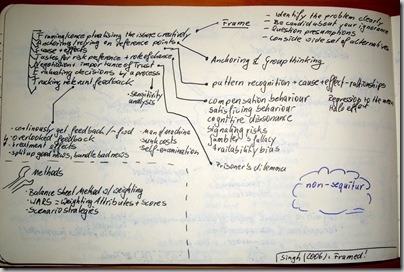Singh, Hari: Framed!; HRD Press, 2006, ISBN: 0874258731
Amazon-Link
I stumbled upon this book somewhere in the tubes. I do admit that I felt appealed to combine a fictional narrative with some scientific subtext. Unfortunately for this book I put the bar to pass at Tom DeMarco’s Deadline. On the one hand Singh delivers, what seems to be his own lecture on decision-making as the alter-ego of Professor Armstrong; on the other hand the fictional two-level story of Larry the first person story-teller and the crime mystery around Laura’s suicide turn murder does not really deliver. Let alone the superficial references to Chicago, which I rather found off putting, I think a bit more of research and getting off the beaten track could have done much good here. Lastly, I don’t fancy much the narrative framework driven style so commonly found in American self-help books – and so brilliantly mocked in Little Miss Sunshine.
Anyhow let’s focus on the content. Singh calls his structure for better decision-making FACTNET
- Framing/ conceptualising the issue creatively
- Anchoring/ relying on reference points
- Cause & effect
- Tastes for risk preference & role of chance
- Negotiation & importance of trust
- Evaluating decisions by a process
- Tracking relevant feedback
Frame – Identify the problem clearly, be candid about your ignorance, question presumptions, consider a wide set of alternatives
Anchoring – Anchor your evaluations with external reference points and avoid group thinking
Cause & effect – Recognise patterns and cause-effect-relationships, try to regress to the mean, be aware of biases such as the halo effect
Tastes for risk & Role of chance – be aware of compensation behaviour, satisficing behaviour, cognitive dissonance, signaling of risks, gambler’s fallacy, availability bias – all deceptions which negatively impact decision-making
Negotiation & Trust – just two words: Prisoner’s dilemma
Evaluating decisions by a process – Revisit decisions, conduct sensitivity analyses
Tracking relevant feedback – Continuously get feedback & feed-forward, be aware of overlooked feedback, treatment of effects, split up good news and bundle bad news, think about sunk costs, man & machine, and engage in self-examination
Three methods for decision-making are presented in the book – (1) balance sheet methods with applied weighting, (2) WARS = weighting attributes and scores, and (3) scenario strategies.
Lastly, Singh reminded me again of the old motto „Non Sequitur!“ – making me aware of all the logic fallacies that occur if something sounds reasonable but ‚does not really follow‘.
